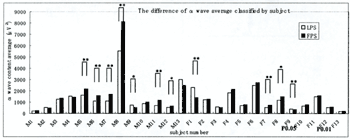|
RESULTS OF EXPERIMENTS
Result of Brain Activity
Table 1 denotes the number of times when brainwaves became more active in case of release of FPS than only audible sound. In addition, other trouble states were not seen during this experiment. As shown in Table 1, alpha wave was activated in nine subjects among thirteen male subjects, and also in ten subjects among thirteen female subjects. Moreover, activation of alpha wave content classified by subjects was expressed in Figure 6. The alpha wave reaction and individual difference for the subjects can be seen in this figure.
Table 1. The quantitative increase number classified by frequency of brain
waves
| (Enlarge: 51KB) |
 |
Figure 6. The difference of alpha wave average classified by each subject
Result of POMS Test
This experiment was the analysis of 25 subjects, except one female subject showing the halo effect. This POMS test was performed after each sound presentation, following POMS evaluation method, and answers which were obtained from 65 items of question were classified by six factors based on five stage consultations value and each factor was compared using T score. Six POMS factor items are "Tension Anxiety", "Depression-Dejection", "Anger-Hostility", "Vigor", "Fatigue" and "Confusion" respectively.
Figure 7-1 shows average of T score on male subjects and Figure 7-2 on female subjects. In many factors presented at FPS presentation sound, T score became lower, showing good state, than at LPS presentation sound. In the case of the male subject, the significant difference was accepted by the factor of "anger-hostility (A-H)"* and "confusion (C)" *(*P<0.05). However, female subjects did not show significant difference. This shows that male subjects were quick to react by the components of ultrasonic wave including FPS presentation sound, but female subjects did not clearly show psychological reaction by those of ultrasonic wave.
Figure 7-1. Average of male subjects
Figure 7-2. Average of female subjects
CONCLUSION
This research further verified existing research on activating effect of ultrasonic waves mainly in the field of music on human brainwaves by producing the same results using the ultrasonic waves contained in the sounds of sea waves. Currently, it is thought that we are only on the way to researching the influence of ultrasonic waves on human beings (Oohashi and Nishina, 1991; Choi and Hotta, 1998, 2001). Up to now, with regard to the influence of ultrasonic waves on brainwaves, there has mainly been quantitative analysis of brainwave activity, but in the future it is important that qualitative evaluation be tried. In the future, if a new evaluation is done of coastal regions from the side of the sound environment including ultrasonic waves, and if those results can be mapped out, it can be used for the development of coastal marine tourism and at the same time, research on the configuration of wave breakers to create comfortable wave sound as well as sound resource management.
REFERENCES
Choi, J-i., S-i. Kanzaki and K. Hotta. 1998. A study on the Physiological effects of ultra-sonic waves of coastal area on human brain waves, Recent Advancement in Marine Science and Technology 1998, PACON International, Honolulu Hawaii, USA
Choi, J-i and K. Hotta. 2001. The effects on the auditory evoked potential caused by ultra-sonic wave property including sound of coastal waves, Proceedings of Japan Society of Acoustics, 2001, Japan
Oohashi, T. and E. Nishina. 1991. High-frequency sound above the audible range affects brain electric activity and sound perception, 91st Convention of the Audio Engineering Society 3207 (W-1), New York.
Oohashi, T. and E. Nishina. 1992. Physiological Influences of Gamuran High-frequency Band-width, Proceedings of Japan Society of Acoustics, Japan.
|